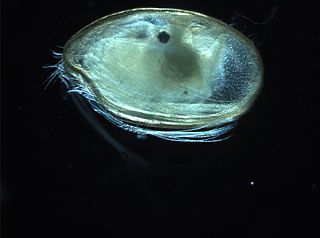
Ostracods, or ostracodes, are a class of the Crustacea, sometimes known as seed shrimp. Some 33,000 species have been identified, grouped into 7 valid orders. They are small crustaceans, typically around 1 mm (0.04 in) in size, but varying from 0.2 to 30 mm in the case of the marine Gigantocypris. The largest known freshwater species is Megalocypris princeps, which reach 8mm in length). In most cases, their bodies are flattened from side to side and protected by a bivalve-like valve or "shell" made of chitin, and often calcium carbonate. The family Entocytheridae and many planktonic forms do not have calcium carbonate. The hinge of the two valves is in the upper (dorsal) region of the body. Ostracods are grouped together based on shell and soft part morphology. While early work indicated the group may not be monophyletic and early molecular phylogeny was ambiguous on this front, recent combined analyses of molecular and morphological data suggested monophyly in analyses with broadest taxon sampling, but this monophyly had no or very little support. They have a wide range of diets, and the class includes carnivores, herbivores, scavengers and filter feeders, but most ostracods are deposit feeders.

The Myodocopida is one of the two orders within the Myodocopa, in turn a subclass of the Ostracoda. The Myodocopida are distinguished by a worm-like seventh limb, and, usually, a rostrum above an incisure (notch) from which the antennae can protrude. Unlike other ostracods, many species of the Myodocopida have lateral compound eyes Over the last thirty years there has been much research into the morphology, behaviour and distribution of myodocopids. More recently, DNA sequences have been used to investigate the phylogeny of various groups.

Cylindroleberididae is a family of ostracods that shows remarkable morphological diversity. The defining feature is the possession of gills: 7–8 leaf-like pairs at the posterior of the body. Other features common to all species in the family include a "baleen-comb" on both the maxilla and the fifth limb, a sword-shaped coxal endite on the mandible, and the triaenid bristles on the basal endites of the mandible.

Pancrustacea is the clade that comprises all crustaceans, including hexapods. This grouping is contrary to the Atelocerata hypothesis, in which Hexapoda and Myriapoda are sister taxa, and Crustacea are only more distantly related. As of 2010, the Pancrustacea taxon was considered well accepted, with most studies recovering Hexapoda within Crustacea. The clade has also been called Tetraconata, referring to having four cone cells in the ommatidia. This name is preferred by some scientists as a means of avoiding confusion with the use of "pan-" to indicate a clade that includes a crown group and all of its stem group representatives.

The Podocopa are a subclass of ostracods. Members of the subclass Podocopa can be differentiated from the other subclass of ostracods (Myodocopa) by the morphology of the second antenna: the Podocopa have a relatively long endopod, whereas the Myodocopa have a relatively long exopod. The seventh limb of the Podocopa has a variety of forms or is absent, but is never an annulated worm-like limb.
Polycopidae is a family of marine ostracods. Its members are related to animals in the suborder Halocypridina, but are sufficiently distinct to be placed in the sub-order Cladocopina. There is even some speculation that a separate order may be warranted. The genera in the family differ from the other suborder, Halocypridina, in several features: the central adductor muscle scars are in a triangular or half-rosette pattern, they lack sixth and seventh limbs, and the maxilla has both an exopod and endopod.
Spelaeoecia is a genus of crustaceans in the family Thaumatocyprididae. One species, the Bermudan endemic S. bermudensis, is listed as critically endangered on the IUCN Red List. It contains the following species:
Krausella is an extinct genus of ostracods. It is the sole genus in family Krausellidae.

Myodocopina is a suborder of ostracods.

Monoplex parthenopeus, common name the giant triton or giant hairy triton, is a species of sea snail, a marine gastropod mollusk in the family Cymatiidae. It preys on other molluscs.

Cypridinidae is a family of ostracods. About half of all known species are bioluminescent. Some use the light only for defence, others also for courtship displays. The linages with sexually dimorphic bioluminescent displays have more species other linages, which indicates that bioluminescent courtship could increase the diversification rates.
Tectonatica sagraiana is a species of predatory sea snail, a marine gastropod mollusk in the family Naticidae, the moon snails.
Limnocytheridae is a family of ostracods, containing the following genera:

Cypridocopina is a suborder of ostracods in the order Podocopida. It is divided into three superfamilies – Cypridoidea, Macrocypridoidea and Pontocypridoidea.
Azygocypridina lowryi, colloquially known as the baked bean, is a species of ostracod crustacean or "seed shrimp" in the family Cypridinidae. It is found in deep waters off the east coast of Australia.
Azygocypridina is a genus of ostracods in the family Cypridinidae, which appears to be "the least derived living ostracod", having remained largely unchanged for 350 million years. It contains the following species:
Cytherella fragum is a species of seed shrimp in the family Cytherellidae.

The clade Multicrustacea constitutes the largest superclass of crustaceans, containing approximately four-fifths of all described crustacean species, including crabs, lobsters, crayfish, shrimp, krill, prawns, woodlice, barnacles, copepods, amphipods, mantis shrimp and others. The largest branch of multicrustacea is the class Malacostraca.
The Rya Formation is a geologic formation in Skåne County, southern Sweden. It is Early to early Middle Jurassic in age. The Rya Formation comprises siltstones, claystones, sandstones, mudstones and rare coal beds. The formation overlies the Höganäs Formation and is overlain by the Vilhelmsfält and Mariedal Formations.
Cytherella is a genus of seed shrimp in the family Cytherellidae.







